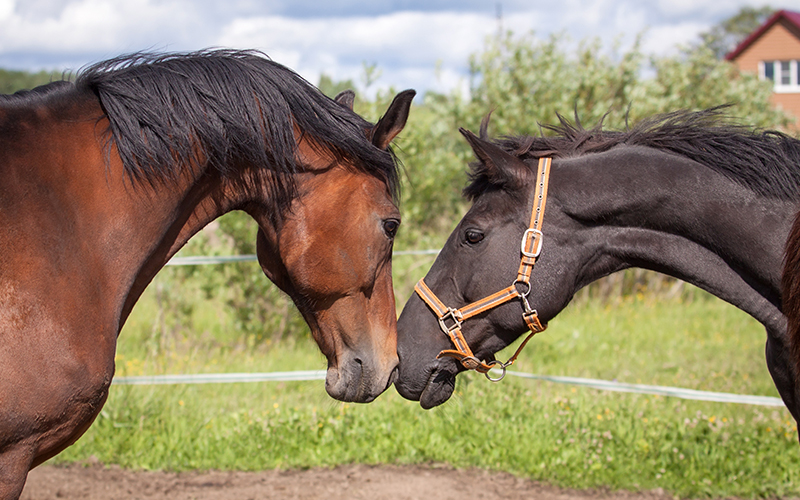Equine Herpesvirus

What is the Equine Herpesvirus?
Equine Herpesvirus-1 (EHV-1), also known as rhinopneumonitis or “rhino”, is an important cause of disease in our horse population. While there are several types of equine herpesvirus, the focus of this article will be on EHV-1, which can cause respiratory disease, abortion, neurologic disease or early foal death. This virus can be highly contagious. Like all herpesviruses, EHV-1 can remain dormant (latent) in the body for periods of time, and then reemerge and cause disease during times of stress, such as transportation or showing.
- The respiratory form is most commonly seen in young horses (<2 years of age).
- The neurologic form tends to cause more severe disease in middle age to older horses.
- The virus is passed from horse to horse in saliva and nasal discharge, or through contact with an infected aborted fetus, placenta or fetal fluids.
- The virus persists in the environment for several hours to days.
The virus can persist in the environment and often contamination or exposure occurs before clinical signs are noticed allowing the rapid spread of disease and occasionally outbreaks when many horses are comingled.
What does Equine Herpesvirus infection look like?
The most consistent sign of all forms of equine herpesvirus is fever (>101.5°F or >36.8°C). Unfortunately, this change is often missed, as signs of a fever are subtle (mild to moderate depression and decreased appetite).
Signs of a respiratory form of infection:
- Watery nasal discharge
- Increased respiratory rate
- Cough
Signs of an abortive form of infection:
- Mare often appears completely normal, but aborts in the last term of pregnancy
- Possible recent history of respiratory disease on the farm prior to an abortion
Signs of a neurologic form (Equine Herpesvirus Myeloencephalopathy/EHM):
- Two fever spikes (bi-phasic fever) a few days apart – the first one may be easy to miss
- Weakness, particularly in the hind limbs, potentially progressing to inability to stand
- Poor tail and anal tone
- Urine dribbling, inability to urinate, difficulty retracting the penis
How is EHV diagnosed?
A complete physical examination by a veterinarian, including a rectal temperature, is critical. Providing your veterinarian with a thorough history of recent travel and potential exposure to other sick horses is very helpful. A sample of your horse’s nasal discharge and a blood sample can be submitted to the laboratory for polymerase chain reaction (PCR) tests, which can identify DNA of the herpesvirus. Additionally, this test can differentiate between the neuropathic and non-neuropathic forms of EHV-1 and give an idea of the amount of virus present, which will help to determine prognosis. Other tests may be recommended by your veterinarian or by a Board-certified Large Animal Internal Medicine Specialist to differentiate EHV-1 from other diseases that cause similar signs.
How is EHV treated?
If any of the above symptoms are noted, it is critical to begin taking temperatures of all exposed horses. A quarantine period of at least 21 days is recommended for an infected horse and accompanying exposed horses in order to prevent further spread of disease. Repeat testing for shedding of the virus will help determine the end of the isolation period.
Respiratory form:
- Treatment is often not required with mild disease if the horse is eating and drinking normally.
- Anti-inflammatory drugs may be required for high fevers or for horses uninterested in food and water.
- Secondary bacterial infection may occur later in disease, requiring antibiotic therapy
Abortive form:
- Isolate the mare who aborted from other horses (especially other pregnant mares).
- Remove all aborted tissues and do not let other horses touch the tissues.
Neurologic form:
- Anti-viral medications and anti-inflammatories are often used.
- Supportive care varies depending on how seriously the horse is affected:
- IV fluid therapy
- Urinary catheter
- Sling to help the horse stand
What is the prognosis for EHV infection?
Horses usually recover uneventfully from the respiratory and abortion forms. However, horses diagnosed with the neurologic form of equine herpesvirus have a more variable prognosis. Some horses recover, but horses who are unable to stand for greater than 24 hours can have a grave prognosis, and owners may elect euthanasia.
How can I prevent my horse from infection?
Vaccines are available for the respiratory and abortion forms of EHV-1, and it is important to discuss a good vaccination schedule with your veterinarian to protect your horse from these forms of the disease.
At this time, there is no vaccine for the neurologic form of EHV-1, so good biosecurity measures are essential for prevention. These measure include:
- Segregating any new arrivals onto the farm for a minimum of 2 weeks
- Taking daily temperatures
- Minimizing contact between horses at shows and events.
Taking your horse’s temperature is the best thing you can do to catch an early fever. If your horse has a fever, seek veterinary care and keep any affected horses isolated from others until your veterinarian clears them of disease.
Edited by:
Freya Stein, DVM, DACVIM (LAIM)
April, 2020
Articles by Specialty
- Cardiology (19)
- Large Animal Internal Medicine (23)
- Neurology (17)
- Oncology (21)
- Small Animal Internal Medicine (29)
Articles by Animal
- Cats (35)
- Dogs (52)
- Farm Animals (5)
- Horses (12)
